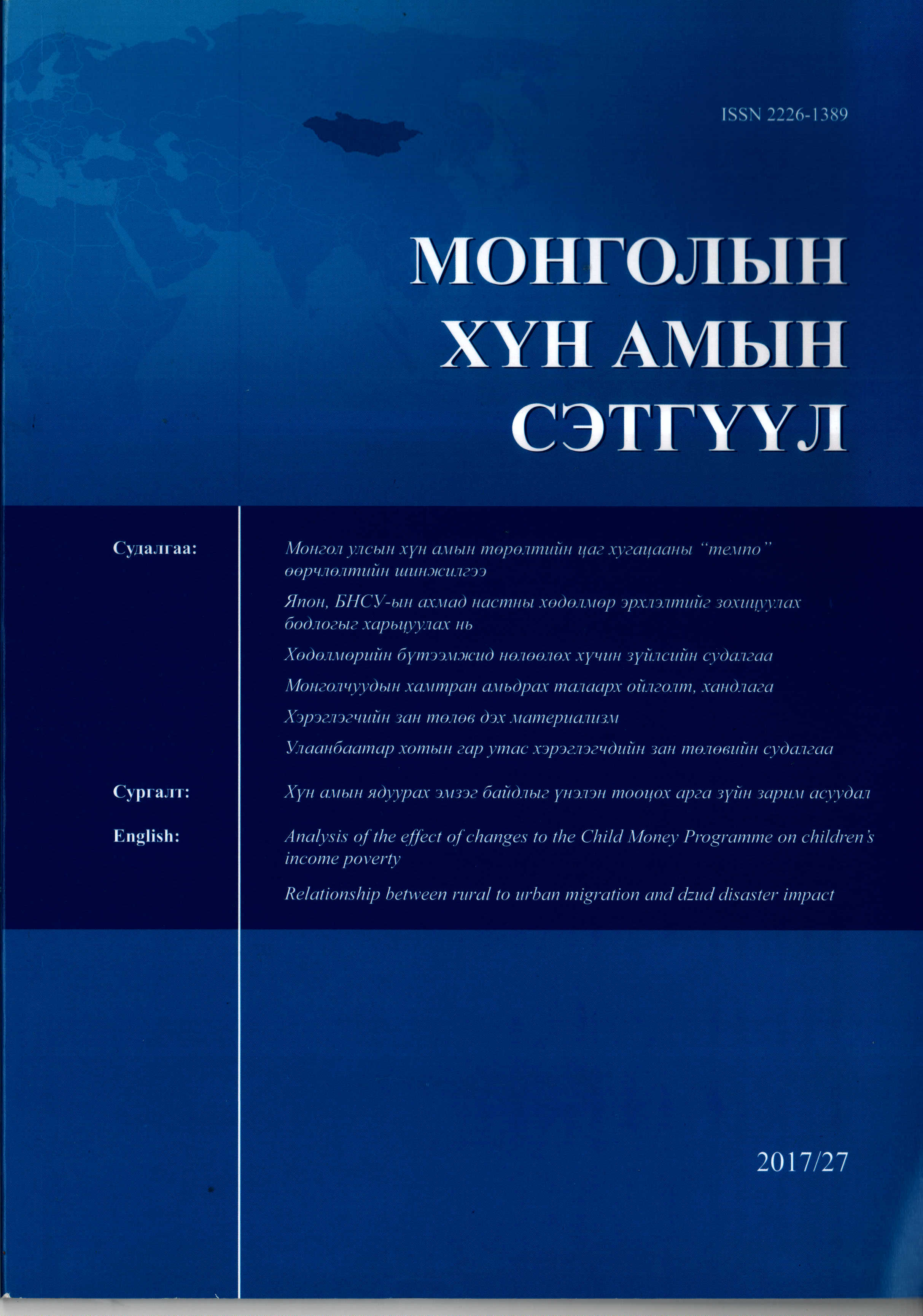Relationship between rural to urban migration and Dzud disaster impact
Main Article Content
Abstract
Хөдөөнөөс хот руу шилжих хөдөлгөөн ба байгалийн гамшигт үзэгдэл Зудын нөлөөллийн хоорондын хамаарлыг шалгах зорилгоор энэ дүн шинжилгээг хийсэн. Дүн шинжилгээнд ҮСХ-ноос гаргадаг макро түвшний хоёрдогч мэдээллийн эх үүсвэрүүд болон баримтын судлалын аргыг ашигласан. Өнгөрсөн 30 жилийн хугацаанд шилжигчдийн дийлэнх нь Улаанбаатар хот руу чиглэж, нийслэлийн хүн амын гуравны нэгийг шилжин ирэгчид бүрдүүлэх боллоо. Энэ нь Улаанбаатрын хүн амын өндөр өсөлтийг мөн Монголын “хотжилт дахь ядуурал”-ыг бий болгож байна. Хөдөөнөөс гадагш шилжих хөдөлгөөн ба алдсан малын тоо хоорондын хамаарлыг шугаман регрессийн загвараа шалгав. Орон нутгаас гадагш шилжих хөдөлгөөн нь алдсан малын тоотой эерэгхамааралтай байв (p=0.004).Өөрөөр хэлбэл, зуднаар малаа алдах буюу цөөн малтай үлдэж буй байдал нь малчдын хөдөөнөөс хот руу шилжин нүүх түлхэх хүчин зүйл болж байна. Түүнчлэн, хөдөө орон нутагт ажлын байр хомс байгаа нь шилжин явах гол шалтгаан болж байна. Өдөр тутмын хэрэглээгээ хангахын тулд хөдөөд орлогогүй, ажилгүй байснаас хот руу ирж хүнд хүчир ямар ч хамаагүй ажил олж хийх боломж илүү байна. Хөгжлийн үр шимээс хүртэх, ажил эрхлэх, орлого олох, өрхийн амьжиргаа тогтвортой байх боломжууд хөдөө орон нутагт бага байна. Эмзэг болон тэгш бус байдлыг бууруулах явдал Монгол улсын хөгжлийн гол шаардлага болж байна. Амьжиргааны аюулгүй байдал, эмзэг байдалд Монгол улсын хүн амын томоохон хэсэг бүлэг үлдсэн хэвээр байна. Иймд хөдөөгийн амьжиргаанд дэмжлэг үзүүлэх, орлогыг олон эх үүсвэртэй болгох явдал амьжиргааны эмзэг байдлыг бууруулах, хөдөө нутагт хүн амаа байршуулах хөгжлийн бодлогын гол гарц болж байна.
This paper examined the relationship between rural to urban migration and natural disasterDzudimpact in Mongolia. Secondary data at macro level from the National Statistical Office of Mongolia was used for the analysis. Existing studies underlie as the literature review. From the last three decades, most of the movement has been towards Ulaanbaatar, with one-third of the inhabitants of the city being in-migrants, which continues to increase the share of the urban population and leads to the “urbanization of poverty” in Mongolia. The analysis was undertaken to test the relationship between rural out-migration and lost livestock by applying a linear regression model. The out-migration has had a positive association with lost livestock (p=0.004). Lost livestock or survival with few numbers of livestock was one of the pushing factors from remote rural to urban areas for herders. Lack of workplaces in rural areas becomes the main cause of out-migration. Job opportunities were more abundant in urban areas instead of being jobless and without income in the countryside, it was better to deal with any works, even a difficult one, to afford for their daily consumption. The view it as an advantage compared to being jobless in the countryside, since employment opportunities enable variety of benefits from development, earning chances, and sustained livelihood of the family.Reducing vulnerability and disparity is a key developmental challenge in Mongolia. Larger segments of Mongolia’s population remain as vulnerable with insecure livelihoods. Therefore, supporting rural livelihood and income diversification is one of the ways to reverse this situation through the reduction of livelihood vulnerability and retain people on the land.
